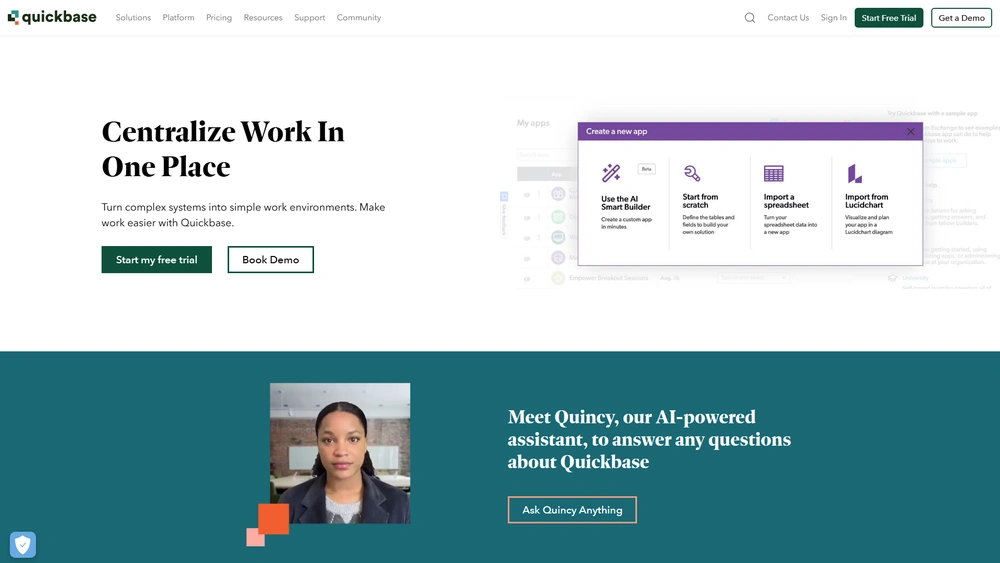Quickbase Overview & 2025 Industry Position
Quickbase is a low-code/no-code application development platform enabling organizations to build and deploy custom business applications without extensive coding expertise. It has long served industries looking for workflow automation, data integration, and real-time collaboration. In 2025, Quickbase is positioning itself as a critical infrastructure tool for operational agility, especially for mid-market and enterprise-scale businesses looking to digitize complex processes without relying entirely on IT departments. Its ability to empower front-line users with customizable workflows sets it apart from traditional software development lifecycle (SDLC) models.
From Launch to 2025: Quickbase’s Journey
Quickbase began in 1999 at Intuit as a database-driven platform for small business apps. In 2016, it was spun off with backing from private equity to accelerate its evolution. Milestones include:
- 1999: Launched under Intuit as a SaaS database offering
- 2016: Acquired by Welsh, Carson, Anderson & Stowe; growth-focused pivot
- 2018: Introduced Pipelines, for advanced automation and workflow triggers
- 2020: Relaunched UX with improved dashboards and mobile experience
- 2023: Added AI-driven insights for form logic and data population
- 2025: Focused on enterprise-grade security, integrations, and AI-based recommendations
Quickbase’s 2025 strategy revolves around facilitating a no-code enterprise operating system — combining flexibility, speed, and IT governance in one platform.

Quickbase Key Features
Quickbase offers a range of tools that enable fast app creation and business workflow management with minimal IT reliance:
- App Builder: Visual development with drag-and-drop elements and templates
- Pipelines: Automation framework to trigger workflows across systems
- Reports & Dashboards: Real-time visualizations customizable by role
- Form Logic: Conditional data entry, dynamic field population
- User Roles & Permissions: Granular access control
- AI Assist: Smart suggestions for table design and integrations
With its focus on integrating capabilities across use cases — from field service to compliance and finance — Quickbase continues to expand utility beyond simple databases.
Workflow & UX
Quickbase’s user experience in 2025 reflects both simplicity and power. From a customizable dashboard to dynamic reports and embedded permissions logic, the interface remains streamlined but highly flexible. Users can create entire applications with guided setup, inline previews, and integrated tutorials. Navigation follows an intuitive left-panel structure with collapsible modules and a top menu for app-wide settings.
Mobile responsiveness and offline data capture features support field-based use cases, while IT governance tools give admins peace of mind. Daily workflows are enhanced through alerts, form rules, and cross-channel triggers that keep teams aligned.
Quickbase Pricing Analysis & Value Metrics
As of July 2025, Quickbase offers three pricing tiers, designed to match usage scale and security needs. Here’s a closer look:
| Plan | Monthly Pricing (per user) | Best For | Key Inclusions |
|---|---|---|---|
| Team | $35 | Small groups, SMEs | 3 apps, basic pipelines, access controls |
| Business | $60 | Growing teams | 50 apps, advanced pipelines, 3X integrations |
| Enterprise | Custom Quote | Large orgs | Unlimited apps, SSO, sandbox, custom SLAs |
Quickbase offers high ROI where workflow complexity justifies the investment. It’s especially valuable where internal IT is stretched thin or where rapid iteration is crucial.
Competitive Landscape
Quickbase’s closest competitors include:
- Airtable: More geared toward creators and design teams; lacks enterprise IT controls
- PowerApps: Great for Microsoft ecosystems; steep learning curve outside of 365
- Smartsheet: Excel-native UX appeals to ops teams; fewer deep integration options
- Appian/OutSystems: Designed for full-stack dev; often too complex for non-technical users
Quickbase’s sweet spot lies in combining security, transparency, and ease of use—ideal for operations-led teams that still need oversight and governance.
Quickbase Use Cases
Quickbase has found adoption across sectors due to its flexible platform design:
- Construction & Field Services: Daily reporting, crew management, bid tracking
- Healthcare: Compliance workflows, credentialing, equipment tracking
- Finance: Budgeting systems, audit management
- Logistics & Supply Chain: Inventory turnover tools, vendor compliance workflows
- Nonprofit: Donor management, program tracking
Its most powerful plays emerge in multi-stakeholder workflows requiring transparency, turnaround speed, and customizable visibility.
Integrations & Extensibility
Quickbase supports over 60 direct integrations, plus thousands more via Pipelines or third-party iPaaS systems:
- Google Workspace, Slack, Jira, Outlook
- Salesforce, HubSpot, NetSuite
- ADP, QuickBooks, and payroll systems
- RESTful API and SDK for custom connectors
The Pipelines feature enables conditional routing, field mapping, filtering, and cross-system auto-triggers. This gives businesses a sustainable way to link tools without reliance on devs.
Pros & Cons
- Pros:
- Fast app deployment with minimal dev
- Highly customizable workflows
- Strong permission management
- Enterprise-grade security and governance
- AI-assisted logic setup and table design
- Cons:
- Steep pricing for smaller businesses
- Learning curve for complex automations
- Limited visual styling options in some templates
Pro Tip: Use Pipelines early in your app design to ensure your data flows align across apps — retrofitting logic later is far more cumbersome.
Final Thoughts
Quickbase strikes the right balance for organizations seeking both agility and oversight. It is not merely a form-and-spreadsheet alternative — it’s a strategic operations layer built for scale, compliance, and flexibility. Though higher tiers are better suited for fast-moving midsize or enterprise-grade teams, even solo departments can benefit greatly if digitizing workflows at a departmental scale.
Quickbase FAQ
Yes, Quickbase is designed for non-technical users with a drag-and-drop interface, helping teams deploy apps rapidly without coding.
Industries like construction, healthcare, finance, and logistical operations rely heavily on Quickbase for custom workflows and compliance management.
Quickbase features SOC 2 Type II compliance, SSO, granular permissions, and audit logs—making it enterprise-grade for security-conscious organizations.
Yes, Quickbase uses AI for smart form logic, table design recommendations, and field mapping assistance.
Yes — the Team plan includes up to 3 apps and limited workflow automations. It’s best for small units trialing the platform or with basic use cases.